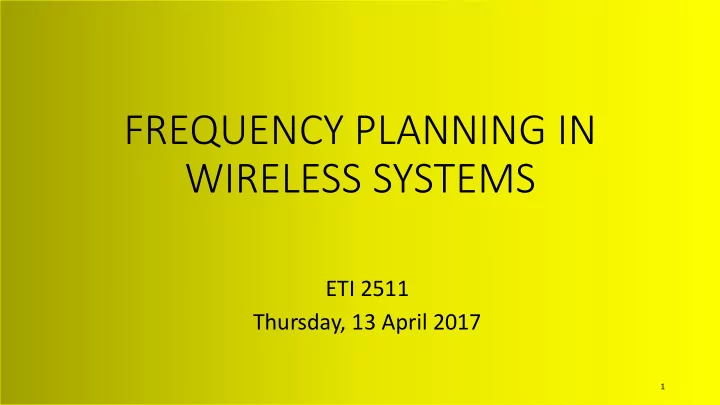

FREQUENCY PLANNING IN WIRELESS SYSTEMS ETI 2511 Thursday, 13 April 2017 1
FREQUENCY PLANNING • Frequency planning refers to the process of analysing and assigning frequencies in a wireless system operating on multiple transmitters in a given geographic area in order to: a) minimize interference b) maximize frequency utilization. • Two key factors that guide frequency planning are: (a)Interference tolerance (b)Distance to reuse ratio 2
RE-USE DISTANCE • Reuse Distance is a measure of the minimum distance between two transmitters in a cellular system and is given by: 𝐸 = 𝑆 3𝑂 Where • N is the number of cells in a cluster. • R is the radius of a cell N = 7 3
FREQUENCY REUSE FACTOR • Frequency reuse factor refers to the rate at which the same frequency can be used in a network. • If the are K cells per clusters, then the frequency reuse factor is given by: 𝐺 𝑆𝑓𝑣𝑡𝑓 = 1 𝐿 • Common frequency reuse factors are: 1 3 , 1 4 , 1 7 , 1 9 , 1 12 4
SECTORED ANTENNAS 1. Most sites employ sectored antennas at one site. 2. If a site has N sectors, then we say it has a reuse pattern of N/K 3. The following reuse patterns have been used in cellular communications: - 3/4 (GSM) - 3/7 (North American AMPS) - 6/4 (Motorola NAMPS) 5
USE OF DIRECTIONAL ANTENNAS 1. Most base stations use directional antennas in order to improve coverage on highways, stadium and buildings. 2. In most GSM systems, this is realized by using a hexadecimal arrangement where towers are located at the corners of the hexadecimals. 3. Each tower has three sets of directional antennas aimed in three directions 120 o apart and receiving/transmitting at different frequencies into three different cells as shown. 6
IMPROVING CAPACITY IN CELLULAR NETWORKS 1. Cell Splitting is the process of sub- dividing congested cells into smaller ones. 2. Advantages: • Splitting preserves the geometry and architecture. • By increasing the number of cells, we also increase the number of clusters which increases the capacity. 7
IMPROVING CAPACITY IN CELLULAR NETWORKS 1. Sectoring introduces more directional antennas to further improve frequency usability. 2. Advantages: • Uses the same base station site and therefore reduces the site acquisition costs. 8
IMPROVING CAPACITY IN CELLULAR NETWORKS • Femto Cells (Microcell Zone ) extends cell boundaries by using fibre optic cables (or microwave relay) links to hard to reach places. 9
Recommend
More recommend